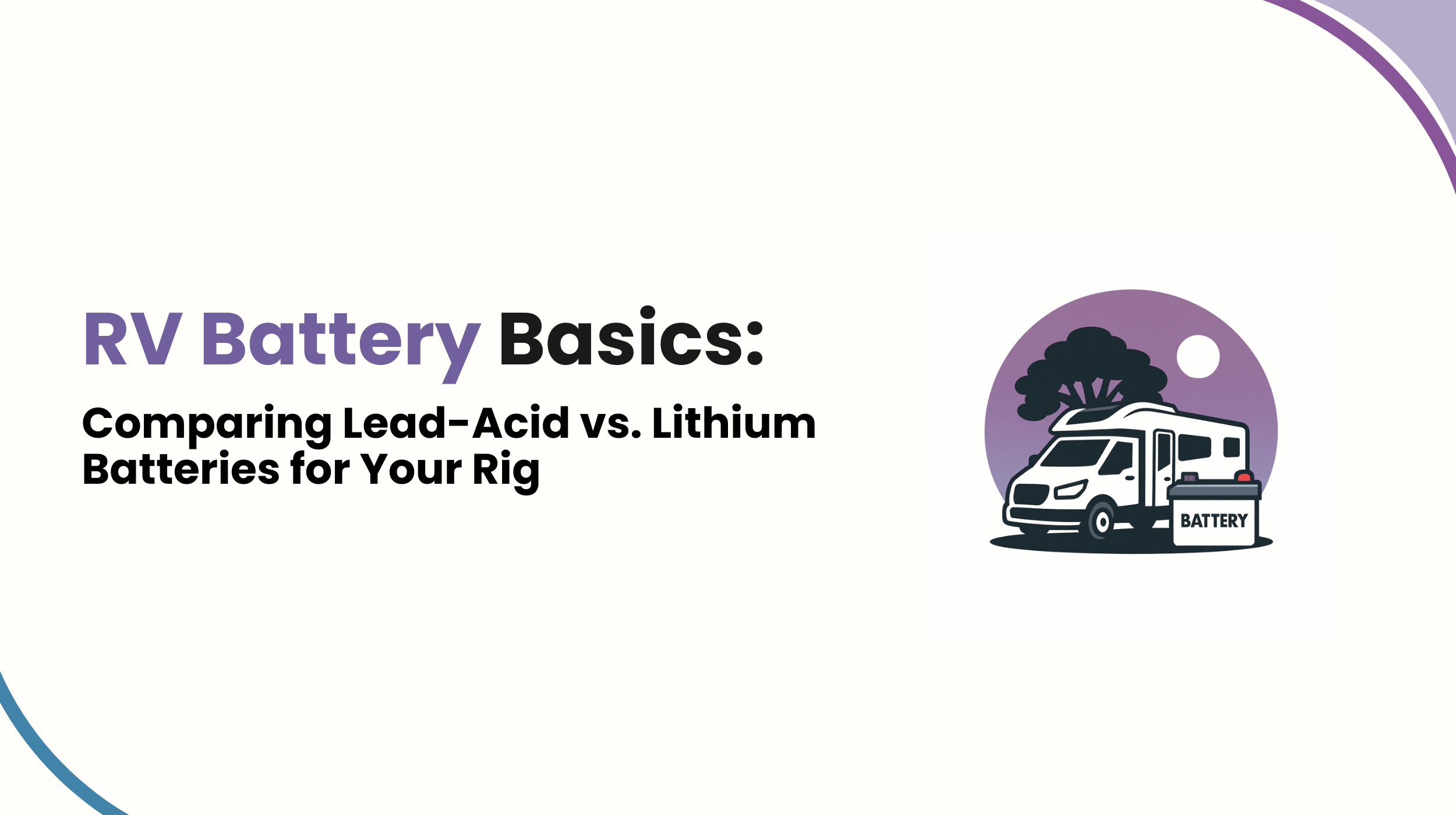TL;DR:
If you’re deciding between lead-acid and lithium RV batteries, think beyond the sticker price. While lead-acid is cheaper upfront, lithium’s longer lifespan, greater usable capacity, lighter weight, and zero-maintenance design often make it the smarter choice, especially for frequent boondockers and full-timers.
Lithium vs. Lead-Acid: The Quick-Glance Comparison for RVers

If you’ve ever stood in front of the battery aisle at an RV supply store, you know the choice can feel overwhelming. These two technologies dominate the market: lead-acid, the tried-and-true budget-friendly option, and lithium (LiFePO4), the high-performance newcomer. This quick table gives you the essentials at a glance, but understanding why these differences matter requires a deeper look, especially if you want to make a decision that will serve you for years, not just your next trip.
A Deep Dive Into the Core Differences
Cost: Beyond the Sticker Price to True Cost of Ownership
Many RV owners make their battery decision based on what their wallet can handle right now. That’s why lead-acid remains popular; it’s easy to spend $200 instead of $900 and feel like you’ve saved money. But batteries aren’t just a one-time purchase; they’re a recurring expense if you choose a technology with a short lifespan.
A more accurate way to compare batteries is by looking at cost-per-cycle, which means how much you pay for each charge/discharge cycle.
- Lead-acid: ~600 cycles at 50% DoD
- Lithium: 2,000 – 5,000 cycles at 80 – 100% DoD
Example Scenarios:
- Weekend User: If you camp 50 nights a year, a lead-acid battery might last a decade. You’ll save money by avoiding the high upfront cost of lithium.
- Full-Time RVer: Using your battery daily, you could burn through a lead-acid battery in two years or less. Over a 10-year span, you’d likely buy 4–5 replacements, spending more than a single lithium battery would have cost.
Mitsubishi Electric highlights that lead-acid replacements are far more frequent, adding both direct costs (buying the battery) and indirect ones (installation time, possible travel delays).
Lifespan and Usable Capacity (Depth of Discharge)
Depth of Discharge (DoD) determines how much of your battery’s capacity you can use before recharging without damaging it. It’s the hidden metric that separates lithium and lead-acid performance.
- Lead-acid (AGM) should only be discharged to ~50% for optimal life.
- Lithium (LiFePO4) can be safely discharged to 80–100% without harm.
This difference means you may need twice the rated capacity in lead-acid to match the usable energy of lithium.
Go Power! explains it well:
“A lithium battery with an overall capacity of 100Ah will give you 80Ah–90Ah, while AGM’s offer only 50Ah.”
Lead-acid batteries are also prone to sulfation, a condition where lead sulfate crystals form on the plates if they’re left partially discharged. This is one of the main reasons lead-acid batteries fail early, something lithium chemistry avoids entirely.
Performance, Power, and Efficiency
When you’re relying on solar or a generator, charging efficiency is a big deal. Lithium batteries can absorb charge faster and hold it better.
- Charge efficiency: Lithium ~95% vs. AGM ~85% vs. flooded ~70–75% (source).
- Voltage consistency: Lead-acid voltage drops steadily as the battery discharges, which can cause lights to dim or appliances to slow. Lithium maintains steady output until nearly empty, keeping systems running smoothly.
- Temperature range: While extreme cold can reduce lithium’s charging ability, they generally perform well across wider temperature swings, ideal for those chasing both summer sun and winter snow.
For boondockers, that means less generator run time, more usable solar energy, and more reliable power delivery.
Weight and Space: The Impact on Your Rig
Every pound counts in an RV. Lighter batteries don’t just make loading easier, they improve handling, fuel economy, and reduce wear on suspension.
A Redodo 12V 100Ah LiFePO4 battery can weigh just 22.16 lbs.
An equivalent lead-acid battery can weigh 60+ lbs.
That’s a 38 lb savings per battery. If you’re running a 4-battery bank, you could shed over 150 lbs, which should be enough to add bikes, kayaks, or extra gear without exceeding weight limits.
Lithium’s more compact size also frees up valuable storage space. According to Go Power!, lithium banks can take up 40% less space for the same energy output.
Maintenance: The “Set It and Forget It” Advantage
Lead-acid batteries, especially flooded types, require regular attention:
- Check water levels and top off as needed
- Clean terminals to prevent corrosion
- Perform equalization charges periodically
AGM batteries reduce these needs but still benefit from occasional checks. Lithium, on the other hand, is maintenance-free. Sealed construction and a Battery Management System (BMS) handle balancing and protection automatically.
That means fewer chores and no need to crawl into awkward battery compartments during your trip.
Safety: Deconstructing the Myths
You’ve probably heard horror stories about lithium batteries catching fire. The truth? Those cases involve different chemistries than what’s used in RV applications.
Consumer devices use lithium cobalt oxide (volatile under certain conditions).
RV batteries use Lithium Iron Phosphate (LiFePO4), which is chemically stable and resistant to thermal runaway, even if punctured.
The integrated BMS adds further protection by monitoring voltage, temperature, and current flow, preventing unsafe conditions before they occur.
For RV owners, that means a battery that’s not only safer than other lithium chemistries but often safer than improperly maintained lead-acid batteries.
Making the Switch: Practical Hurdles of Upgrading to Lithium
Lithium upgrades aren’t always drop-in replacements. Before switching, consider:
- Converter/charger: Older models have charging profiles optimized for lead-acid and can damage lithium.
- Wiring: Lithium can accept higher charge currents, which may require thicker wiring for safety and efficiency.
- Battery monitoring systems: May need reprogramming or replacement to read lithium’s charge state accurately.
- Tow connections: Some 7-pin connectors are inadequate for charging lithium from your tow vehicle.
Forum discussions often reveal RVers who’ve switched without addressing these points and ended up frustrated when their new batteries underperformed.
So, Which RV Battery is Right For You?
Scenario 1: The Casual Weekender
- Few trips/year
- Campgrounds with shore power
- Budget-focused
Best choice: AGM lead-acid – affordable and sufficient for light use.
Scenario 2: The Avid Boondocker & Full-Timer
- Frequent off-grid stays
- High daily power demands
- Wants long-term reliability and less maintenance
Best choice: Lithium (LiFePO4) – higher upfront cost but lower cost per year and better performance.
Choosing an RV battery isn’t just about cost; it’s about value over time.
For light users, a quality lead-acid battery can be the economical choice. But for most RVers, especially full-timers or boondockers, LiFePO4 lithium batteries deliver unmatched longevity, efficiency, and peace of mind.
Think of it as investing in your freedom, not just buying a battery.
Frequently Asked Questions
Is it worth switching to an RV lithium battery?
Yes, if you camp often or depend on your battery for off-grid power. The long-term cost savings, performance gains, and reliability outweigh the initial price.
What is the biggest disadvantage of a lithium RV battery?
The high upfront cost and the possible need to upgrade your RV’s charging system.
Can I use my old lead-acid charger for a new lithium battery?
Not recommended. Lead-acid chargers often won’t fully charge lithium and can shorten its lifespan. A lithium-compatible charger is best.
What is a BMS and why is it essential for lithium batteries?
The Battery Management System monitors and protects the battery from overcharging, over-discharging, and overheating, ensuring safe, long-lasting operation.

